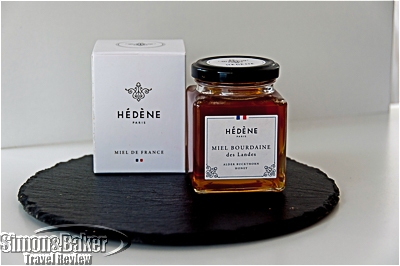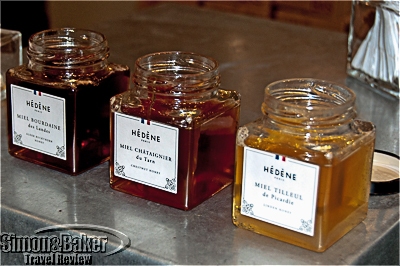Monofloral honeys bring diverse regional essences of France to the table
Article and photos by Josette King
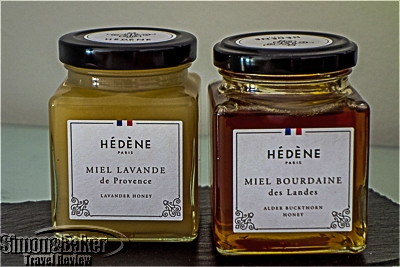
Signature Hédène cube jars were a common site on the shelves of gourmet shops
“Please hand me the rosemary honey,” my friend asked. I was wedged in a corner of her diminutive Paris kitchen where she was whipping up an impromptu dinner while we caught up after a long separation. “Honey in the vinaigrette?” I thought as I reached on the shelf above my head for a cube-shaped jar filled with rich amber liquid. “The rosemary,” she insisted, “the light one.” I glanced at the jar in my hand. A smart white label announced “Hédène Miel Sapin du Jura” (Jura Mountains Fir Honey). I reached up again for an identical jar, that one filled with a silvery concoction. “That’s lavender,” she said absentmindedly, arm stretching above me to retrieve a third jar just a notch darker, a pale champagne color. I couldn’t resist asking: “why do you need all this honey?”
“This is not just honey,” she pointed out, “it’s pure monofloral honey. The right one can do wonders for just about any dish. Smell it.” Having just branded myself a honey philistine, I inhaled the “Lavande de Provence.” It had a delicate, complex scent that took me back to warm Provencal evenings. “We’ll have it for dessert,” she volunteered, “drizzled over mixed red berries and yogurt.” By now I was taking a whiff of “Sapin du Jura.” It did hint at a walk in an evergreen forest. “We’ll try it for breakfast tomorrow; on pain perdu (French toast). Think of maple syrup, only much more subtle, with an elegant lingering palate.” I felt we had just crossed into the elite spheres of wine tasting.
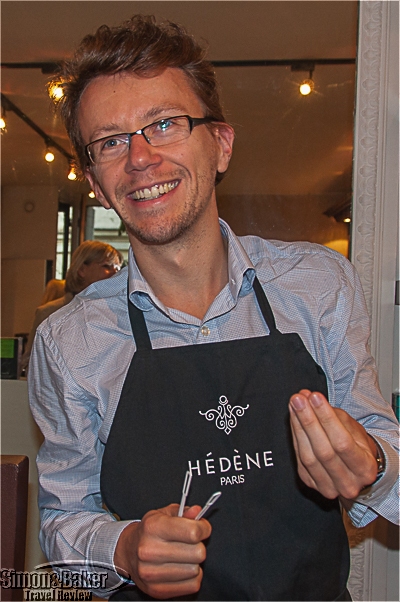
Cyril Marx explaining the finer points of monofloral beekeeping
This impression was confirmed a couple of weeks later when I attended an Hédène honey tasting at a Latin Quarter gourmet shop (86 rue de l’Université, 75007 Paris, France, +33 6 63 04 98 82 86, http://www.hedene.fr/en/, contact@hedene.fr ). I immediately spotted my three old acquaintances Sapin du Jura, Lavande de Provence and Romarin du Languedoc among a display of the signature cubes with their tailored white labels and black tops. The collection also included Acacia de Bourgogne (Burgundy Acacia Honey), Tilleul de Picardie (Picardy Linden Honey) and Châtaignier du Tard (Tarn Valley Chestnut Honey), lined in a palette ranging from the palest of golds to rich copper.
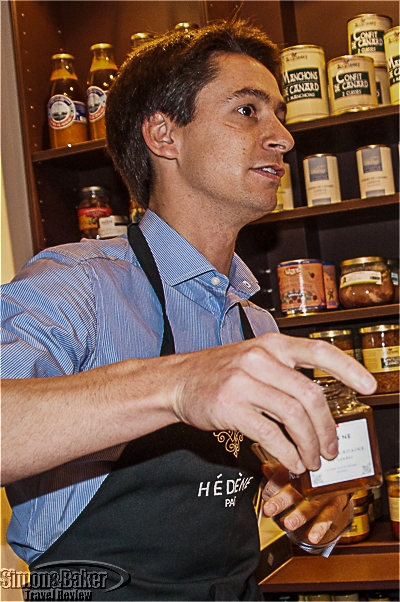
Alexis Ratouis conducting a tasting of Hédène honeys
But mostly I met the two enthusiastic young men clad in matching dark grey aprons, who were orchestrating the proceedings, Cyril Marx and Alexis Ratouis, the cofounders of Hédène, a brand of premium French monofloral artisan honeys created in 2013; and I got the answer to my unspoken question: what makes Hédène honeys so special that they have already garnered preeminent space on the shelves of épiceries fines (gourmet shops) throughout France; and gained staple status in the pantry of my Parisian gourmet friend?
The newly introduced Bourdaine des Landes was the star of the honey tasting (click to enlarge)
Cyril and Alexis met at university in Paris and developed a friendship based on common interests including apiculture. Cyril’s family has kept hives in the Cevennes for four generations, while Alexis’ relatives keep their own bees in Savoy. Both men have enjoyed participating in honey harvests since childhood. Even as they completed their education and began their professional careers, they nurtured their passion for apiculture at le Rucher Ecole du Jardin du Luxembourg (founded in 1856, the Luxembourg Garden Hive is recognized as the oldest ongoing urban hive in France, and one of its most prestigious apicultural teaching institutions). After two years of intense planning, they decided to make it their career. Hédène was launched that year.
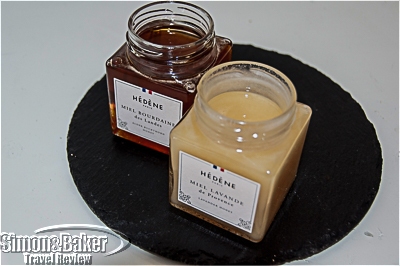
My current Hédène favorite French monofloral honeys
“We aim to take our customers on a journey of the diverse regions of France. All our honeys are unique monofloral vintages issued from a flower characteristic of its area of origin, each with its distinctive color, taste and texture,” Cyril explained.
In each area, they select artisans who uphold the highest standards of traditional beekeeping. Those chosen suppliers also commit to adhering to the rigorous specifications set by Hédène. But how do they ensure that the bees will make single flower honey? The selected beekeepers in areas where the target plant predominates must time the introduction of the hive and the actual harvesting of the comb to coincide with the peak blooming period. To be chosen as an Hédène product, the honey must be analyzed and laboratory certified to contain the required pollens.
Because of these rigorous requirements, as in the world of fine wines, the quantities of an especially prized vintage may be limited.
Hédène monofloral honeys ready for tasting (click to enlarge)
It was the case with the Miel Bourdaine des Landes (Adler Buckthorn Honey from the southwestern France Atlantic coast) being introduced that day. It was the color of fine Cognac, full bodied with a delicately astringent, quince-like finish. There will be no more than 2,000 jars available this fall, and with the holiday gifting season coming up I doubted they would last long on the market. I immediately purchased two jars, one for my honey connoisseur friend, the other one for myself. I can’t wait to hear what she thinks of it. As for me, I expect it will be delicious as a glaze for roasted pork tenderloin. And by the way, that tablespoon of Miel Romarin du Languedoc did work wonders for the vinaigrette on our mixed summer’s greens salad.

